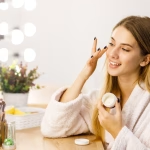Skin care routine steps involves several key steps to maintain healthy, radiant skin. Start with cleansing to remove dirt and impurities, followed by exfoliation to slough off dead skin cells. Apply a toner to balance skin pH and prep it for better absorption of serums and treatments. Moisturize to lock in hydration and protect your skin’s barrier. Don’t forget sunscreen during the day to shield your skin from UV damage. Each step plays a crucial role in achieving a clear, glowing complexion and addressing specific skin concerns effectively. Tailoring these steps to your skin type ensures optimal results.
Cleansing – The Foundation of a Healthy Skin care Routine
When it comes to maintaining healthy, glowing skin, cleansing is often the unsung hero of a skincare routine. While serums, moisturizers, and treatments all play their vital roles, cleansing forms the cornerstone of any effective skincare regimen. Let’s explore why cleansing is so crucial, how to choose the right cleanser, and the best techniques to ensure your skin looks and feels its best.Skin care routine steps
Why Cleansing Matters
- Removes Dirt and Impurities
Throughout the day, your skin encounters a range of impurities, from pollution and dirt to sweat and makeup. A thorough cleansing routine helps remove these elements, preventing them from clogging your pores and causing breakouts.Skin care routine steps - Prepares Skin for Better Product Absorption
When your skin is free from residual grime and oils, serums, moisturizers, and treatments can penetrate more effectively, enhancing their benefits. - Maintains Skin Health
Regular cleansing helps balance your skin’s natural oils. Over time, an imbalance in oil production can lead to various skin issues, including dryness, excessive oiliness, and acne. A good cleansing routine helps keep your skin’s oil production in check, promoting overall health.
Choosing the Right Cleanser
Here’s a quick guide to help you choose:
- For Oily Skin: Look for a gel or foaming cleanser. These types help remove excess oil and control shine without over-drying your skin.Skin care routine steps
- For Dry Skin: Opt for a cream or hydrating cleanser. These are designed to clean without stripping your skin of its natural moisture.
- For Combination Skin: A mild, balanced cleanser that can address both oily and dry areas is ideal. Consider a gentle gel or a milk-based cleanser.
- For Sensitive Skin: Choose a fragrance-free, soothing cleanser that won’t irritate or cause redness. A micellar water or a gentle cream cleanser can be a great choice.
Cleansing Techniques for Optimal Results
- Double Cleansing
This technique involves using two types of cleansers – typically an oil-based cleanser followed by a water-based one. The oil-based cleanser removes makeup and excess sebum, while the water-based cleanser addresses any remaining impurities.Skin care routine steps - Gentle Exfoliation
Incorporating gentle exfoliation into your cleansing routine helps remove dead skin cells and prevent buildup that can lead to dullness and clogged pores. - Proper Application
Apply your cleanser using clean hands and lukewarm water. Massage the cleanser into your skin in circular motions for about 30 seconds to ensure a thorough cleanse. - Rinsing and Drying
Rinse your face thoroughly to ensure no cleanser residue remains. Pat your skin dry with a clean, soft towel – avoid rubbing, as this can cause irritation and damage.Skin care routine steps
Building a Consistent Routine
For the best results, cleanse your face twice a day – once in the morning and once before bed. Morning cleansing helps remove any overnight build-up and prepares your skin for the day ahead, while evening cleansing removes the day’s impurities and allows your skin to rejuvenate overnight.Skin care routine steps
Final Thoughts
Cleansing might seem like a simple step, but its importance cannot be overstated. It lays the foundation for a healthy skincare routine by ensuring your skin is clean, balanced, and ready to absorb the benefits of other skincare products. By choosing the right cleanser and incorporating effective techniques into your routine, you set the stage for radiant, healthy skin.Skin care routine steps
Exfoliation – Renew Your Skin with Gentle Buffing
In the quest for radiant, healthy skin, exfoliation often emerges as a game-changer. This process involves removing dead skin cells from the surface of your skin, revealing a fresher, more vibrant layer underneath. But while exfoliation can offer remarkable benefits, it’s essential to do it right to avoid irritation and achieve the best results. Here’s a comprehensive look at exfoliation – why it’s important, how to choose the right method, and tips for incorporating it into your skincare routine.Skin care routine steps
Why Exfoliation is Essential
- Reveals Brighter Skin
Exfoliation removes these cells, allowing the fresh, new skin underneath to shine through. This can instantly enhance your skin’s radiance and improve overall texture. - Unclogs Pores
Dead skin cells and impurities can clog pores, leading to breakouts and congestion. Regular exfoliation helps keep your pores clear, reducing the likelihood of acne and promoting smoother skin.Skin care routine steps - Improves Product Absorption
When your skin is free of dead cells and buildup, it can better absorb the active ingredients in your serums and moisturizers. This means your skincare products work more effectively, delivering optimal results.Skin care routine steps - Enhances Skin Texture
Exfoliation can help smooth out rough patches and uneven skin texture. Whether your skin is bumpy due to clogged pores or feels uneven from sun damage, gentle exfoliation can refine and polish your skin’s surface.Skin care routine steps
Choosing the Right Exfoliation Method
Here’s a breakdown to help you choose the best method for your skin type and concerns:
- Physical Exfoliation
Physical exfoliants involve scrubbing or buffing the skin with granular substances. These include exfoliating scrubs, brushes, and sponges.Skin care routine steps- Best for: Normal to oily skin types that can handle a bit of abrasion. Avoid if you have sensitive or inflamed skin.Skin care routine steps
- Tips: Choose exfoliants with fine, smooth particles to prevent micro-tears in the skin. Use gentle pressure and avoid over-exfoliating.Skin care routine steps
- Chemical Exfoliation
Chemical exfoliants use acids or enzymes to dissolve dead skin cells and promote cell turnover. Common types include alpha hydroxy acids (AHAs) like glycolic acid and beta hydroxy acids (BHAs) like salicylic acid.Skin care routine steps- Best for: All skin types, including sensitive skin, depending on the formulation. Chemical exfoliants can also address specific concerns like acne or hyperpigmentation.
- Tips: Start with lower concentrations and gradually increase as your skin builds tolerance. Follow with sunscreen, as chemical exfoliants can increase sensitivity to the sun.Skin care routine steps
Incorporating Exfoliation into Your Routine
- Frequency
Exfoliation should be done regularly but not excessively. For most people, 1-3 times per week is ideal.Skin care routine steps - Timing
Exfoliation can be performed in the morning or evening, depending on your preference and the type of exfoliant. If using a chemical exfoliant, it’s often recommended to apply it at night and follow with sunscreen during the day.Skin care routine steps - Application
For physical exfoliants, apply a small amount to damp skin and gently massage in circular motions. For chemical exfoliants, follow the product’s instructions – they may be applied directly or incorporated into a toner or serum. - Aftercare
Post-exfoliation, your skin might be more sensitive. Apply a soothing moisturizer to hydrate and repair your skin barrier. Avoid using other potentially irritating products, such as retinoids or harsh actives, immediately after exfoliating.Skin care routine steps
Tips for a Safe and Effective Exfoliation
- Patch Test: Before using a new exfoliant, perform a patch test to ensure it doesn’t cause irritation or allergic reactions.
- Listen to Your Skin: If your skin feels sore, dry, or irritated, scale back on exfoliation and focus on hydration and soothing.Skin care routine steps
Final Thoughts
Exfoliation, when done correctly, can rejuvenate your skin and enhance your overall complexion. By selecting the right exfoliation method and integrating it thoughtfully into your skincare routine, you can achieve a brighter, smoother, and healthier appearance. Remember, balance is key – gentle, consistent exfoliation will help you unveil the best version of your skin.Skin care routine steps
Toning and Treatment – Balancing and Targeting Your Skin’s Needs
In the journey to achieving flawless skin, toning and treatment play crucial roles in fine-tuning and addressing specific skin concerns. While cleansing lays the foundation and exfoliation refines your complexion, toning and treatment steps are essential for balancing your skin and targeting its unique needs. Here’s a detailed look at how these steps contribute to your skincare routine, and how you can make the most of them for healthier, more radiant skin.
The Role of Toning
- Restores pH Balance
After cleansing, your skin’s natural pH balance can be disrupted. Toning helps restore this balance, ensuring your skin remains neither too oily nor too dry. A well-balanced pH is essential for maintaining the skin’s protective barrier and overall health.Skin care routine steps - Prepares Skin for Treatment
A good toner prepares your skin to better absorb subsequent products. By removing any residual impurities and closing the pores slightly, toners create an optimal environment for serums, treatments, and moisturizers to penetrate effectively. - Hydrates and Refreshes
These ingredients can provide an extra boost of moisture, refresh the skin, and calm any irritation or redness.Skin care routine steps - Minimizes Pores
Certain toners contain astringent ingredients that can help tighten and minimize the appearance of pores. This is especially beneficial for those with oily or combination skin who are looking to achieve a smoother, more refined complexion.Skin care routine steps
Choosing the Right Toner
- For Oily or Acne-Prone Skin: Look for toners with salicylic acid or witch hazel. These ingredients help control oil production and reduce acne-causing bacteria.
- For Dry or Sensitive Skin: Opt for alcohol-free toners with soothing ingredients like chamomile or rose water. Hydrating agents like hyaluronic acid are also great for maintaining moisture levels.
- For Combination Skin: Choose a balanced toner that can address both oily and dry areas. Formulas with mild exfoliants or balancing ingredients like green tea can be beneficial.Skin care routine steps
- For Mature Skin: Toners with anti-aging ingredients such as antioxidants, peptides, or retinol can help improve skin texture and reduce the appearance of fine lines.
Understanding Treatment Products
Treatment products are designed to target specific skin concerns and enhance your overall skincare routine. These can include serums, spot treatments, and masks, each formulated to address particular issues.
- Serums
Depending on your skin’s needs, you might choose serums for anti-aging, brightening, hydrating, or acne treatment. They are typically applied after toning and before moisturizing.Skin care routine steps - Spot Treatments
For localized issues such as blemishes or dark spots, spot treatments provide targeted solutions. Ingredients like benzoyl peroxide, salicylic acid, or hydroquinone can be effective depending on your concern. - Masks
Face masks can offer intensive treatment for various skin issues. Whether you’re looking for a hydrating mask, a clarifying clay mask, or a revitalizing sheet mask, incorporating masks into your routine can provide a boost of nutrients and address specific skin concerns.Skin care routine steps
Incorporating Toning and Treatment into Your Routine
- After Cleansing: Apply toner to a clean face. You can use a cotton pad or your hands to gently pat the toner onto your skin. Avoid rubbing, as this can cause irritation.
- Apply Treatment Products: After toning, apply your treatment products as directed. Serums should be applied in a thin layer and allowed to absorb before moving on to the next step.Skin care routine steps
- Follow with Moisturizer: To lock in the benefits of your toner and treatment products, apply a moisturizer suited to your skin type. This will help seal in hydration and further address your skin’s needs.
- Consistency is Key: For best results, incorporate toning and treatment products into your daily routine. Consistency ensures that your skin receives ongoing care and benefits from the active ingredients.Skin care routine steps
Tips for Optimal Results
- Patch Test New Products: Before incorporating new toners or treatments, perform a patch test to check for any adverse reactions.
- Adjust Seasonally: Your skin’s needs may change with the seasons. Adjust your products and routine to accommodate changes in weather and skin condition.
- Listen to Your Skin: Pay attention to how your skin responds to different products and make adjustments as needed. Overuse of certain treatments can lead to irritation.
Final Thoughts
Toning and treatment are vital components of a comprehensive skincare routine. By carefully selecting products that balance and target your skin’s unique needs, you set the stage for a healthier, more radiant complexion. Embrace these steps as part of your daily regimen, and enjoy the transformative benefits they bring to your skin.Skin care routine steps
Moisturizing and Sun Protection – Hydrating and Shielding for Daily Care
In the realm of skincare, moisturizing and sun protection are two fundamental steps that should never be overlooked. They are your skin’s best defense against environmental damage and dehydration, playing a crucial role in maintaining a healthy, youthful appearance. Here’s a closer look at why these steps are essential and how to incorporate them into your daily routine for optimal skin health.Skin care routine steps
The Importance of Moisturizing
- Hydrates and Nourishes
Moisturizers are designed to replenish and lock in moisture, preventing your skin from becoming dry and flaky. They create a barrier that helps retain water, ensuring your skin remains hydrated and plump throughout the day. This is vital for all skin types, as hydration supports overall skin function and resilience.Skin care routine steps - Maintains Skin Barrier
A well-formulated moisturizer strengthens the skin’s natural barrier, which protects against external aggressors like pollution, harsh weather, and irritants. A healthy skin barrier prevents moisture loss and helps defend against conditions such as eczema and dermatitis.Skin care routine steps - Smooths and Softens
Regular use of a moisturizer can improve skin texture, making it smoother and softer. By reducing dryness and flakiness, moisturizers can help diminish the appearance of fine lines and create a more even complexion. - Enhances Skin Repair
Moisturizers often contain ingredients that support skin repair and regeneration, such as vitamins, peptides, and fatty acids. These ingredients can aid in healing damaged skin and improving its overall health and appearance.
Choosing the Right Moisturizer
- For Oily Skin: Look for lightweight, oil-free, or gel-based moisturizers. These provide hydration without adding extra oil or clogging pores.
- For Dry Skin: Opt for richer, cream-based moisturizers that offer deep hydration and help restore moisture balance.
- For Combination Skin: A balanced, non-comedogenic moisturizer that addresses both dry and oily areas is ideal. Lightweight creams or lotions can work well.
- For Sensitive Skin: Choose hypoallergenic, fragrance-free moisturizers with soothing ingredients like aloe vera or chamomile to minimize irritation.
The Crucial Role of Sun Protection
- Prevents Premature Aging
Sun exposure is one of the leading causes of premature aging. UVA and UVB rays can break down collagen and elastin, leading to wrinkles, fine lines, and loss of skin elasticity. Using sunscreen helps protect your skin from these harmful effects, maintaining a youthful appearance. - Reduces Risk of Skin Cancer
Regular use of sun protection is crucial for reducing the risk of skin cancer. UV radiation is a major risk factor for developing various types of skin cancer, including melanoma. Sunscreen provides a critical barrier against these harmful rays. - Prevents Hyperpigmentation
Sun exposure can lead to uneven skin tone and dark spots, often referred to as hyperpigmentation. Sunscreen helps prevent these discolorations by shielding your skin from the sun’s harmful rays. - Maintains Even Skin Tone
Sun protection helps keep your skin tone even by preventing redness and discoloration caused by sun damage. It’s an essential step in achieving and maintaining a uniform complexion.
Selecting the Right Sunscreen
- Broad-Spectrum Protection: Choose a sunscreen that offers broad-spectrum protection against both UVA and UVB rays. This ensures comprehensive protection from the full spectrum of sun damage.
- SPF Rating: For daily use, a sunscreen with SPF 30 is generally recommended. Higher SPF values provide greater protection, but SPF 30 is adequate for most daily activities.
- For Oily or Acne-Prone Skin: Look for oil-free or gel-based sunscreens that won’t clog pores. Mineral sunscreens containing zinc oxide or titanium dioxide can also be a good choice.
- For Dry Skin: Opt for hydrating sunscreens with added moisturizers or emollients. Cream-based sunscreens can provide extra hydration while protecting your skin.
- For Sensitive Skin: Choose sunscreens formulated for sensitive skin, ideally with physical blockers like zinc oxide or titanium dioxide. These are less likely to cause irritation.
Incorporating Moisturizing and Sun Protection into Your Routine
- Morning Routine: Start your day by applying a moisturizer to a clean face. Allow it to absorb fully before applying sunscreen. Use a broad-spectrum sunscreen as the final step of your morning skincare routine, even on cloudy days or when staying indoors.
- Reapplication: For prolonged sun exposure, such as during outdoor activities, reapply sunscreen every two hours. If you’re sweating or swimming, use a water-resistant formula and reapply more frequently.
- Evening Routine: At the end of the day, cleanse your face to remove sunscreen and other impurities. Follow up with a moisturizer to hydrate and repair your skin overnight.
Final Thoughts
Moisturizing and sun protection are indispensable components of a comprehensive skincare routine. By keeping your skin hydrated and shielding it from the sun’s harmful rays, you lay the groundwork for a healthier, more resilient complexion. Embrace these steps as part of your daily regimen to ensure your skin remains vibrant, youthful, and well-protected.Related article














